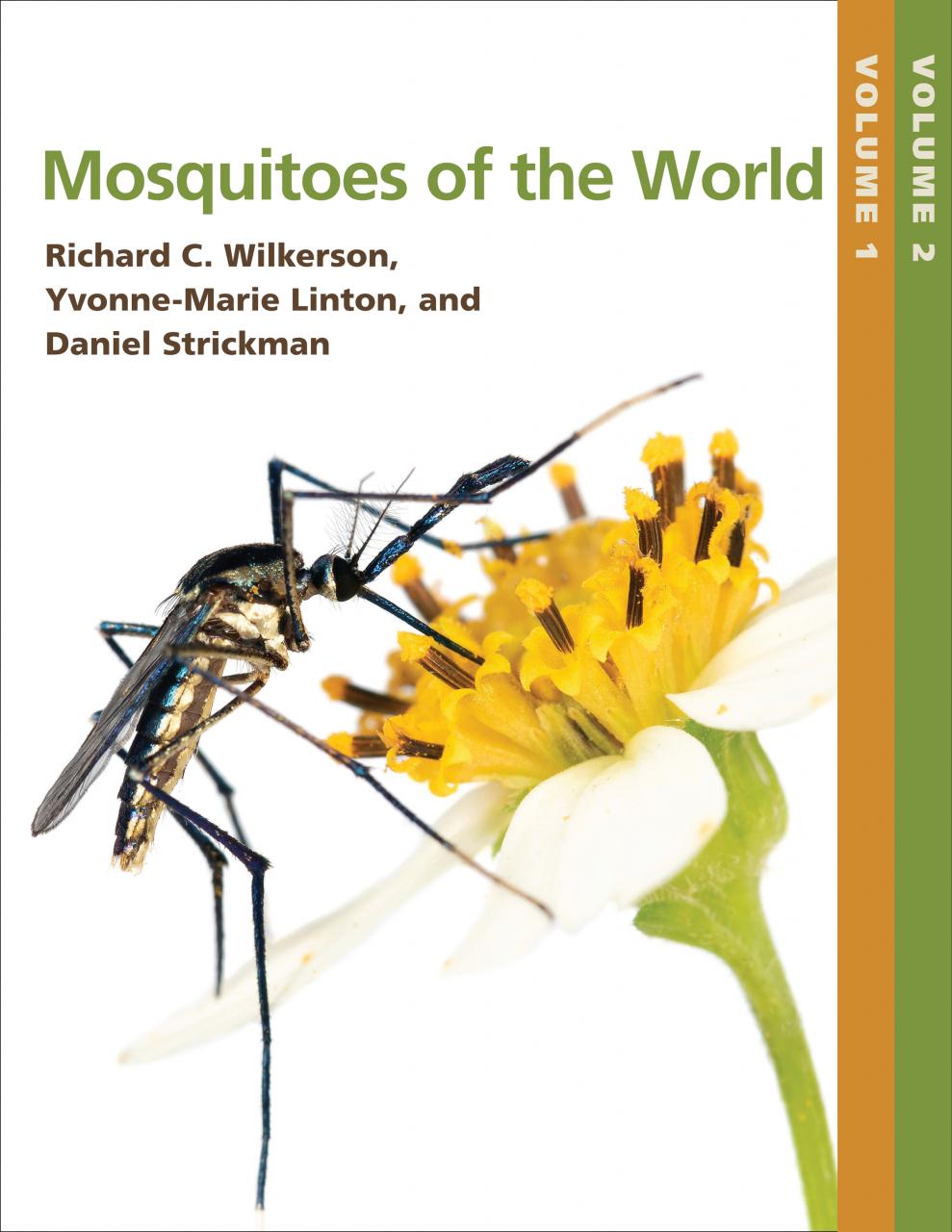Richard C. Wilkerson, Yvonne-Marie Linton & Daniel Strickman
Johns Hopkins University Press
2021
ISBN: 9781421438146
Reviewed by Graham White
This monumental pair of volumes, boldly entitled Mosquitoes of the World, cover almost everything known about mosquitoes plus what they mean to science and humanity. The narrative text is lucid, replete with precious inferences supported by >6000 references, expounding wider principles of biosystematics, ecology, evolution, insect behaviour and physiology, while comprehensively reviewing mosquitology. Augmenting the internet resources that evolve daily, this solid monograph (weight >5kg) summarizes and expertly interprets information on every recognized species of mosquito for anyone to understand, enjoy and evaluate. Volume 1, Part 1 Biology chapters explain mosquito evolution,
nomenclature, classification, identification (without keys), distributions, development, dormancy, movements (of eggs, larvae, pupae, adult males and females), feeding and nutrition (of larvae and adults), excretion and reproduction (copulation, insemination, egg development and oviposition), pest and vector roles but not mosquito control. Part 2 defines 41 mosquito genera and gives profiles of 128 important species (each portrayed on double-page spread with synoptic text, beautiful illustrations and distribution map) comprising bionomics, diagnostic morphological characters with annotated pictures to facilitate identification of each species and group, citations of exemplar genomes and DNA barcodes; also specifying pathogens of medical interest (arboviruses, filarias, malarias) associated with and potentially transmitted by each mosquito species. Following an essential Glossary of >300 morphological structures used for mosquito identification, the main subject index of ~7000 terms completes Vol. 1 (x + 599 pages).
The bigger Volume 2 (600-1308 pages) contains the updated global ‘Taxonomic Catalog of Culicidae’ comprising 3570 named species and 130 subspecies of mosquito (Family Culicidae in the insect Order Diptera), formally classified into 41 genera and 187 subgenera with informally ranked Tribes, Series, Sections, Groups/subgroups of species, plus complexes of sibling species, many pending formal description and naming under the Rules of Zoological Nomenclature. Guided by the systematic accounts and supporting references in this book, all these taxa can be identified, investigated, understood and classified phylogenetically. Earlier catalogues of the global mosquito fauna were published by Theobald (1905), Edwards (1932), Horsfall (1955 bionomics), Stone et al. (1959) and Knight & Stone (1977) plus the Culicipedia by Harbach (2018 CABI) whose online Mosquito Taxonomic Inventory (MTI) http://mosquito-taxonomic-inventory.info/ already includes newly described mosquito species (>1/month) since this book went to press. Due to the so-called ‘taxonomic impediment’ (Coleman, 2015: J. Crust. Biol. 35: 729-740) many newly-recognized species of mosquito lack Linnean names and are omitted from the MTI, whereas this comprehensive book covers those reported until mid 2020. MoW authors Wilkerson, Linton & Strickman have all served as managers of the Walter Reed Biosystematics Unit at the Smithsonian Institution www.wrbu.si.edu which ostensibly maintains the Mosquito Catalogue online http://mosquitocatalog.org although it has lapsed since 2016 and the website refers enquiries to Vol. 2 of this book instead. Mosquito scientific names are indexed separately for each Volume. Literature References are cited for each species, genus and tribe in their catalogue entry (Vol. 2), but omitted from their synoptic profile page (Vol. 1), so the reader may be tantalized by cross-checking. Innumerable Figures are mostly original diagrams (~200) and colour images (~170), each worth at least a thousand words.
Tabulated lists of valuable details bolster the narrative text, summarizing topics such as the ‘timeline of events in culicid history’ – ‘mosquito fossils in chronological order’ – 46 ‘substances in mosquito saliva that affect host responses’ and 308 ‘viruses detected in various mosquito genera’. The most intriguing Table 2.6 proposes ‘common names for genera of mosquitoes’ (with linguistic explanations) including Nail Mosquito for Anopheles, Pointy Mosquito for Aedes,Typical Mosquito for Culex, Submarine Mosquito for Mansonia and Gang Mosquito for Psorophora. Hence the catalogue entry for every species gives it an informal English name of 4 or 5 words, intending to provoke more interest in mosquito speciation! Among the more familiar species, Aedes albopictus remains the Asian Tiger Mosquito, whereas Aedes aegypti is awkwardly called the ‘Yellow Fever Malaysian Pointy Mosquito’; Culex pipiens and Cx. quinquefasciatus usually known as northern and southern house mosquitoes are called the ‘Piping Swedish Typical Mosquito’ and the ‘Five-banded American Typical Mosquito’ respectively. Among the many erudite examples, Mansonia indiana is called ‘Yawadvipa Indonesian Submarine Mosquito’ since its type-locality in Java, Indonesia, was previously in the Hindu kingdom of Yawadvipa (~2220 years ago), although this species prevails more across the Indian subcontinent. Hopefully these peculiar names will remain follies of this publication. Who would want to use them instead of latinized names for such infamous vectors as the Anopheles gambiae complex of sibling species – for which the proposed informal English names are: Amharic Ethiopian Nail Mosquito (NM) for An. amharicus; Arab Yemeni NM for An. arabiensis; Bwamba Ugandan NM for An. bwambae; Coluzzi Malian NM for An. coluzzii [ignoring forms GOUNDRY and TENGRELA (Tennessen et al., 2021: Mol. Ecol. 30:775-790)]; Fontenille Gabonian NM for An. fontenillei (rejected by MTI for being published only electronically); Malaria Gambian NM for An. gambiae itself; Black Gambian NM for An. melas [ignoring allopatric divergences (Deitz et al., 2016: G3 6: 2867-79)]; Unadulterated (misinterpretation of seaside) Tanzanian NM for An. merus, and Four-ringed South African Nail Mosquito for An. quadriannulatus? Conversely this book glosses over controversies and instability with conventional nomenclature and systematics of anopheline and aedine genera/subgenera that have confused mosquito literature recently.
The quality of this truly magnum opus gains much from its robust and flawless printing by JHU Press, at reasonable price. Despite avoiding the applied field of mosquito control and minimizing the veterinary roles of mosquitoes while emphasizing their medical importance, which is why they are so exhaustively studied and understood biologically, this indispensable book should boost the value of mosquitoes in ecological, evolutionary and other fields of investigation, while standing as a landmark publication in mainstream entomology


